
|   |

|   |
Nakshatra Dance Festival at NCPA - Dr. Sunil Kothari e-mail: sunilkothari1933@gmail.com Photos courtesy: NCPA November 6, 2013 Visiting Mumbai and participating in the Nakshatra Dance Festival at the National Centre for the Performing Arts (NCPA) was like coming back home. Since its inception, NCPA was our familiar ground, our comfort zone. We would attend all the events, felt very 'high' and were full of dreams. Seniors and elders, encouraged us. Dr. Jamshed Bhabha, Dr. Narayan Menon, Pandit Ravi Shankar, Soli Batlivala at Akashganga Building at Bhulabhai Desai Road (former Warden Road, where NCPA started), were icons we looked up to. The dream of Dr. Jamshed Bhabha to have a Centre comparable to Lincoln Centre in New York, at Nariman Point indeed came true. The Tata Theatre, the Little Theatre, the Experimental Theatre, the Godrej Dance Theatre, the Sunken Garden, the Dr. Jamshed Bhabha Auditorium, the Library, the Guest House, the Piramal Gallery, the (former Rangoli ) resturant / cafe invariably drew us like magnet. At NCPA, legendary dancers, musicians and actors gave memorable performances. The archive, systematically built up over the years, is a treasure trove. And the present management under the leadership and guidance of the Chairman, Khushroo N Santook is proud to carry on the legacy enriching the life of the nation. I used to say: 'Take Sunil Kothari anywhere, you cannot take Bombay out of him!' I was filled with that feeling once again. I stayed at the NCPA Guest House for nearly a week, giving lectures on dance scholarship, on writing books, publications, guiding young dancers about Fulbright Fellowship, moderating discussion on educating audiences post performance with three leading dancers from Mumbai, Kolkata and Aurangabad. Engaging in conversation with the heads of dance, theatre, music, archives, library and watching performances of visiting dance companies from Kolkata, Odisha, Kerala, interacting with them, marveling at the logistics, overcoming natural calamities and managing to arrive from Bhubaneswar which faced heavy rains, storm disruption of rails, uncertainty in reaching in time. Taking all these in their stride, artiste community, meeting each other, comparing notes and going on stage for rehearsals, was exciting. Swapanokalpa Das Gupta, Odissi dancer and head of the dance department, has considerable experience in art management, with a background of having worked at Bharatiya Vidya Bhavan in London and organizing various art related activities. NCPA is drawing praise from all involved. Nakshatra Festival started in Oct 2009 and was conceptualized and curated by Arundhati Subramaniam, the then Head of dance. Amrita Lahiri joined in 2010 and continued her legacy. Now Swapnokalpa succeeds in inspiring artistes with enthusiasm to offer their best. The audience response has also been heartwarming. Swapnokalpa, her colleagues Neha Kadalgaokar and senior colleague, old timer Biniafar, and others, including the staff at the Experimental Theatre, lights designer displayed artistic sensitivity which makes the events at NCPA of such high quality. Attention is paid to all details and artistes and audiences feel comfortable enjoying the performances. 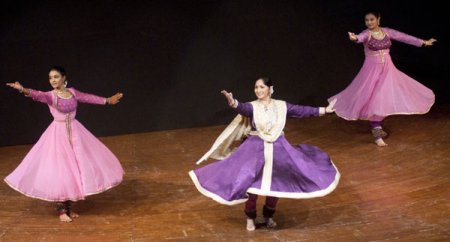 Uma Dogra and troupe 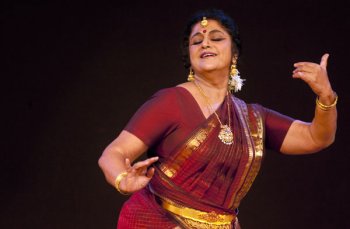 Chitra Visweswaran 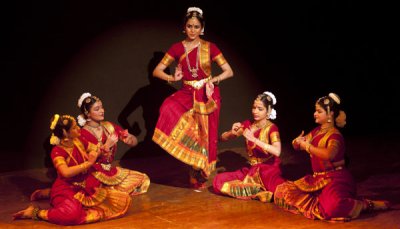 Chidambaram Dance Company Nakshatra Dance Festival (19th till 28th October) began on 19th with Kathak group choreography titled Kathakars of Jaipur, by Mumbai based seasoned Jaipur gharana Kathak dancer Uma Dogra and her troupe, followed by Anubhuti, choreographed by the celebrated Bharatanatyam dancer from Chennai, Chitra Visweswaran and her Chidambaram Dance Company troupe. Both the productions, as I gather from those who had seen them, were very successful and were well received. Both Uma Dogra and Chitra Visweswaran have vast experience in their respective fields. 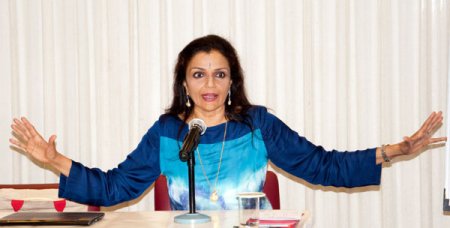 Dr. Anita Ratnam 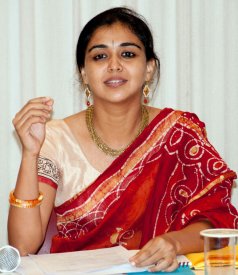 Sanjukta Wagh 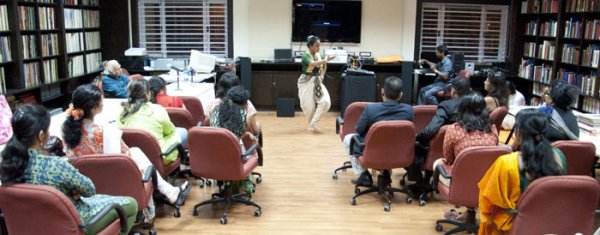 Prateesha Suresh demonstrating Sattriya dance 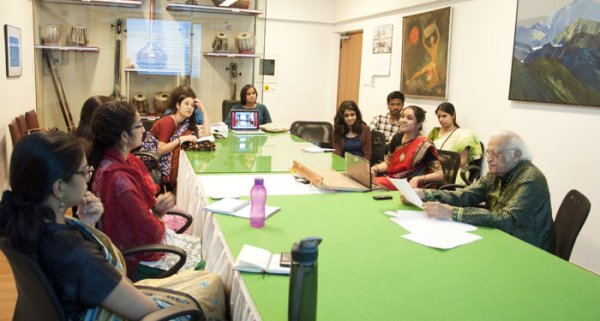 Dr. Sunil Kothari The other workshop was on guiding dancers applying for Fulbright Fellowship. We screened 'online 'details from Unites States Education Foundation. Explaining various fellowships available, educational requirements, preparations for proposals, selection of area for studies, we went through the application form and acquainted dancers on how to go about it. We referred to Fulbright fellowships, to name a few given to artistes like Priti Patel who studied training of spastic children, Sruti Bandopadhyay who went as a lecturer, Vaishali Trivedi who visited Los Angles under fellowship for learning choreography and Arshiya Sethi who got fellowship for art management at Lincoln Centre. I was offered Fulbright Fellowship to teach as a Professor at Georgia University, Evergreen College and UCLA, Los Angeles in USA and shared my experience teaching there. Speaking about Application of Research - Choreography, Kathak and Odissi dancer Parwati Dutta gave an account of how she chose to join Mahagami Gurukul at Aurangabad and undertook research in that area where art of dance is rare for marginalized community. She began from scratch. She researched in the history of Aurangabad where Sarangadeva (13th century) had written the musical treatise Sangitaratnakara. She researched in music and found how Devagiri Bilawal raga was composed there; she also performed at Devagiri to Bilawal raga. Her researches in Dhrupad and tala employed in her choreographed works were an eye opener. She also screened excerpts of her choreographic work where all seven classical dance forms were used and how Nirgita mentioned in Natya Shastra was woven. 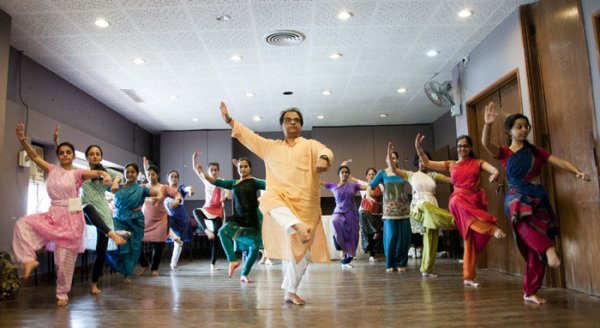 Ratikant Mohapatra conducting Odissi workshop Choreographed by Sruti Bandopadhyay, a disciple of Guru Bipin Singh, Kalavati Devi and Darshana Jhaveri in Manipuri, the dance drama 'Jaya Jaya Bhanu Jaya Jayadeva' from Kolkata brought the exquisite poetry of 12th century poet Jayadeva and Gurudev Rabindranath Tagore's 19th century Bhanusingher Padabali in a seamless manner, both in terms of music and movement striking familiar chords in the hearts of the rasikas, who well versed in both Sanskrit and Brajabuli hummed the songs as the dance drama progressed. Gorgeously dressed in Manipuri costumes with gossamer veils, mirrored skirts, it opened with Nandi composition by Prof Arum Kumar Basu: 'Jaya Jaya Bhanu, Jaya Jayadeva, Jaya Manipur Jaya Bangam, Jayajaya nartana vilasitamangal, jaya karatala mridangam,' followed by the pung cholom, drum dance of Manipur by Manipuri dancers, evoking a feeling of auspiciousness. Sritakamalakucha mandal prayer from Gita Govinda along with Bhanusingher Padabali songs when the Gopis moved in circle, extolling the beauty of nature, the melodious 'kuhu kuhu' notes of the koel bird transported one to the bowers of Braj. The love between Krishna and Radha echoing in these songs, epitomizing human soul's longing to merge with divine, finds felicitous expression in the lyrical Manipuri movements. When Krishna and Radha appeared in Rasamandapa, it created magical moments. The dance drama concluded with lamp arati as performed in Manipur with devotees singing and dancing, leaving an indelible impression. The choreography by Sruti was uncluttered, smooth flowing from one sequence to another interspersed with drum dancing. All the dancers performed in harmony. The music by Tarit Bhattacharya merged with Gurudev's tunes and Manipuri music. Somnath's set design was effective. In Mumbai, one sees very few performances of Manipuri made popular by the pioneering Jhaveri Sisters. Sruti, following their tradition did a most welcome presentation highlighting Manipuri dance form. 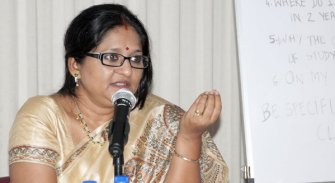 Sruti Bandopadhyay 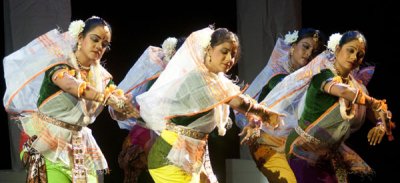 Sruti Bandopadhyay's troupe 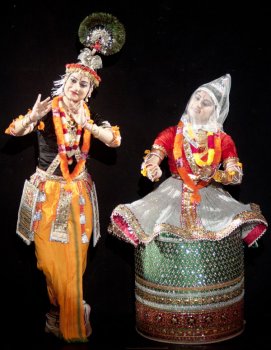 Debangana Chakraborty as Krishna & Somabha Bandopadhyay as Radha 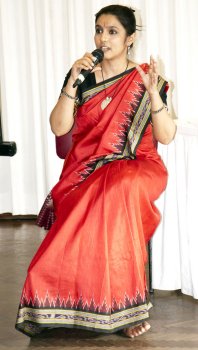 Parwati Dutta In the post performance session, Darshana Jhaveri emphasized the need for educating audiences with excellent presentations, maintaining devotional aspect, and also demonstrating salient features of the dance form for the uninitiated in the audience. The Jhaveri Sisters used to present Manipuri in Mumbai regularly, and Darshana said audiences need to be encouraged to watch dance regularly, bringing their children to classical performances. Sruti spoke about the situation in Kolkata. Dance and music loving Bengali audiences do support the art. When presenting her dances, Sruti explains the spiritual aspect of dance. She said that dancers have to meet the challenge of other entertaining forms and strive to maintain high standards to educate the public. In a big city like Kolkata, classical dance needs to be preserved against all odds. Parwati Dutta from Aurangabad threw light on how in an area where dance is not so recognized, with help of Mahagami Gurukul she has succeeded in bringing awareness of various dance forms there. She resorted to various strategies, meeting local leaders, editors of newspapers, inviting them to performances and generated interest among people in dance with perseverance and succeeded in a large measure. Moderating the discussion, I referred to the problems classical dance faces in the Capital, where unfortunately there has been an overkill of dance and on account of entry to dance performances being free, there has been an adverse effect. In order to educate public it is necessary to install respect for the dance, what SPIC MACAY movement is doing creating awareness by taking celebrated artistes to colleges and schools and creating audiences for classical dance. A concerted effort needs to be made by all concerned to re-establish dance to its glorious position. At Srjan festival held at Bhubaneswar in September, I was able to see Ratikant Mohapatra's choreography of 'Gitamritam.' Watching 'Nirjharini,' one realizes how admirably he has matured and choreographs with imagination and clear concepts. He enlists support from scholars for libretto. With a sense of aesthetics, going beyond what his father, the legendary Guru Kelucharan Mohapatra in terms of aharya, costumes drew from his own Jatra background, Ratikant consciously devised elegant costumes for all participants and left it to the imagination of the discerning audience to work out who was playing what role. For group choreography of items like Pallavis, these costumes enhance the visual appeal. And for characterization in ekaharya lasyanga, artistes dressed in the same costume and playing different roles, or even in dance drama the use of the same costume has brought certain elegance and beauty. Add to it the excellent lighting designed by him and Debiprasad Misra, aka Tikki, the overall production values make his works very professional, imbued with contemporary sensibilities. Till 1980, I used to attend workshops of Kelubabu at NCPA, and had watched Ratikant learning mardala (pakhavaj), dance, choreography, assist his guru and absorb all Guruji taught. This has equipped him with an ability to carry forward the legacy of his venerable father. The quality time that he spent with Guruji wherever he conducted workshops, has given him insight into the dance form. He has been extending the form, pushing the boundaries. The Srjan troupe's training is flawless, synchronization perfect, and offers visual delight. It indeed is a pleasure and matter of pride that Ratikant with maturity displays his extraordinary gifts in a delectable manner and remains open to criticism with a view to further embellish his art. The five numbers he chose to present had Dayananda Saraswati's 'Bho Shambho' extolling the virtue of the Lord. Dancers in group choreography displayed patterns which were arresting, centripetal, centrifugal, had diagonal lines, straight lines, variations in circles, filling the stage to the lilting music and appropriate mood lighting. Hamsadhwani Pallavi reconstructed from Kelubabu's choreography for a solo dancer, showed how Ratikant uses space, draws attention to the patterns and not to individual dancers. The music by late Bhubaneswar Misra has a haunting quality. Adapting it for dancers, it seemed rich and explored the sculpturesque quality when four dancers in four directions stood still and others danced in centre stage. From pure dance to the episode of Jatayu's attempts to protect Sita and in battle with Ravana, getting killed, had dramatic moments and lament of Sita owning her own fault and not blaming Lakshmana, to the chaupais of Tulasidas, Rajashree as Sita and Ratikant as Ravana kidnapping her in a chariot brought to the piece enough poignancy. However, when the roles were switched, Ratikant enacting role of Jatayu bird and Rajashree enacting role of Ravana, generally one resorts to the suspension of disbelief. For the uninitiated audience, another dancer playing role of Jatayu would have enhanced the appreciation of the work. Of course, after a while the story is so powerful that one forgot Ratikant playing Ravana and got involved in seeing his characterization as Jatayu bird, with one wing chopped off by Ravana. In search of Sita, Rama on seeing wounded Jatayu on the floor, takes him on his lap and gently nurses him. It was a very touching moment. Rama's offering him water and conducting final rites when his soul leaves for heaven to the soulful singing of the chaupai was very moving. The group dancing in praise of Rama filled up the stage. Bhagawati Stotram highlighted Goddess's benign and demonic aspects, in particular, when she kills demon Mahishasura. The tantric images were striking. Killing of demons Shumbha Nishumbha, other dancers forming backdrop, often reminded one of the pata chitra paintings of Odisha. Since Guruji was an expert painter and was well versed in it, his choreography often reflected his ability to create scenes reminiscent of pata chitra. Ratikant seems to have adopted that approach and many a scene were successfully mounted. The Goddess in the centre and devotees circling round her had breathtaking visuals with magical lighting. The costumes were also designed to enhance the mood of Durga and Shakti. Her manifestations as per different epithets were imaginatively worked out, carving images with tantric and sculpturesque overtones. 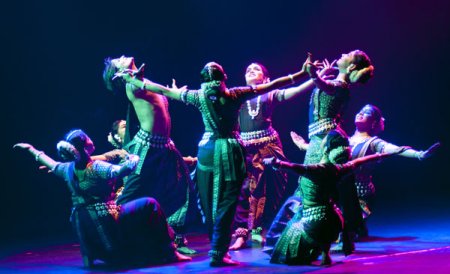 Bhagawati Stotram by Srjan troupe In measured tone, Odissi exponent Daksha Mashruwala gave the gist of the items which gave entry points to the audience to the dance choreography. And as mentioned earlier, the lighting added another dimension to dance. Debiprasad Misra deserves kudos. One looks forward to seeing more of Ratikant's choreographic works. All dancers including Ratikant and Sujata's daughter Preetisha performed with high professional standard. Since the curated program is titled Nakshatra, the dance choreography of Ratikant was a brilliant star in the constellation! 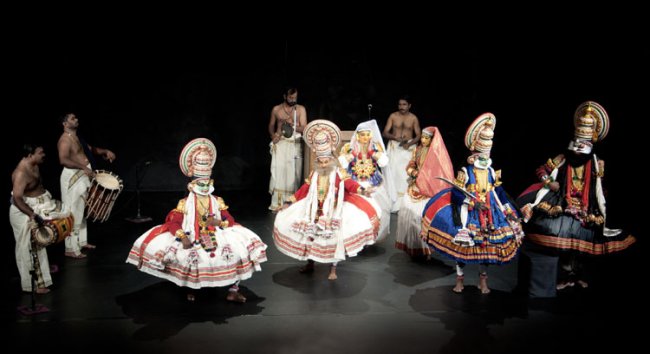 Othello 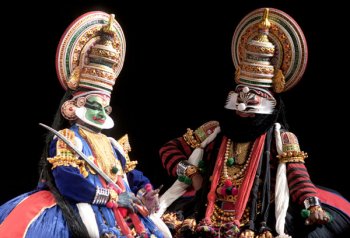 Sadanam Balakrishnan as Othello (left) in conversation with Iago On 27th October, Sadanam P V Balakrishnan's troupe arrived from Kerala to perform 'Othello' in Kathakali, based on Shakespeare's play, but adapted, scripted, written in Manipravalam by Sadanam (addressed as Sadanam sir) with sur titles at Experimental Theatre. I was asked to briefly introduce Sadanam sir. The previous day, I was asked to introduce Ratikant Mohapatra. It was like old times, when I used to introduce artistes at NCPA, Sur Singar Samsad and Kal-ke Kalakar festivals. Sadanam sir was my neighbor at Asiad Village in Delhi. By the time I could interact more with him, Sadanam sir left for Kerala, as he retired from International Centre for Kathakali of New Delhi as a Principal and main performer, teacher. Trained by Kondiveetil Narayanan Nair Asan from a very young age, he also received training at the Gandhi Seva Sadanam Kathakali Academy in Palakkad for eight years and followed up with two year post- diploma course. After retirement he was invited by Kalakshetra Foundation in Chennai to teach Kathakali as a visiting faculty. He also performs regularly and in a few productions, Leela Samson has performed with him. He has performed Othello many times and this version was revised by him. Lyrics, libretto are written by him and his sur titles were polished up in English by friends who had better command over English, said Sadanam sir. They were brief and to the point. Since Sadanam sir wrote the lyrics, the sur titles were close to the Manipravalam text. I could follow Sanskrit words which were adequately translated into English. It helped the audience immensely to follow the main story line. In the end, Othello after killing Desdemona, draws a dagger and kills himself. Sadanam sir said that he had seen a film in which in the beginning their death was shown, both dead and lying near each other. Once Sadanam sir began the Kathakali dance drama with that scene and then in flashback staged the play. But he has now abandoned that and starts with Iago talking with Roderigo taking bribe from him and telling him to go to Desdemona's father Brabanzio that his daughter was per force stolen by Othello and has married her. Iago is full of vengeance against Othello and wishes to take revenge by planting seeds of suspicion in Othello's mind against his wife. Meanwhile, Roderigo succeeds and Brabanzio comes to court and complains to the King about his daughter being kidnapped and married to Othello. However when Desdemona and Othello were brought to the court to prove their innocence, the King was convinced and pardons them, but while parting the father Brabanzio curses Desdemona that as she had deceived her father, she would deceive her husband. What a tragic dramatic irony! Iago continues to scheme against Othello and gets Cassio drunk through Roderigo, and when he sees him begging Desdemona to ask Othello to forgive him and reinstate in service, Iago brings Othello to show what is going on behind his back and poisons his mind, indicating that Desdemona is having an affair with Cassio. He is enraged and does not listen to the pleadings of Desdemona. She tries to pacify him and takes a handkerchief to wipe his perspiration, but he walks away in anger. Iago manages to snatch away the handkerchief from the maid with a vile design. Confused and full of suspicion, Othello takes the handkerchief produced by Iago, as given to Cassio as a token of Desdemona's affection for him, goes through self -torture suspecting Desdemona's motives and enters her chamber to kill her. Those were the most moving moments as performed by Sadanam as Othello and the artiste impersonating Desdemona. The conflict, the agony, the bewilderment on part of Desdemona at Othello's outburst, suspicion and the helplessness, and finally being gagged with handkerchief by Othello succumbing to death, Othello's pain at what he had committed and drawing a dagger and killing himself, falling over her dead body were enacted with such intensity that watching this tragedy the audience was as it were, aghast. So powerful was the impact. After the hand held curtain was drawn over Othello and Desdemona, and finally the prayer was sung by musicians, the audience spontaneously got up and gave the artistes standing ovation. I was overwhelmed seeing this. Rarely have I seen a Kathakali performance receiving such ovation. That the sur titles helped was obvious. With that strategy, I think Kathakali dance dramas would become accessible to the uninitiated audiences. And even for Kathakalibhrantans, Kathakali aficionados, it offers enough time, after glancing through sur titles, to relish the abhinaya on part of the actors. I wish to congratulate NCPA for this excellent ploy. And recommend all to have Kathakali with sub titles. Sadanam sir as Othello, the actor impersonating Desdemona with her seductive gestures, womanly graces and netrabhinaya, Iago with his fury, rage and extreme anguish to take revenge, Cassio in a cameo role and Roderigo as gullible victim of Iago gave memorable performances. The vocal support by the musicians was excellent as they invested their singing with appropriate bhavas, evoking sympathy for Desdemona and Othello. The accompanists on chenda, maddalam, gong, cymbals and edakka gave highly commendable support. It is not easy to sponsor a Kathakali troupe travelling with elaborate costumes, instruments and a large contingent of artistes, make-up men and other assistants all the way from Kerala to Mumbai. That NCPA took this initiative speaks volumes for their support of traditional arts. The very fact that more than 200 strong audience bought tickets and watched the performance with rapt attention seemed to me such a miracle. Living in the Capital and the way Delhi audiences walk in and walk out of classical dance performances, so despicable, and to see Mumbaikars, showing due respect to the artistes and paying for tickets was for me a pleasant surprise. Alas, Delhiites would wake up and show that respect to dancers.  Dr. Sunil Kothari is a dance historian, scholar, author and a renowned dance critic. He is Vice President of World Dance Alliance Asia Pacific India chapter, based in New Delhi. He is honored by the President of India with Padma Shri, Sangeet Natak Akademi award and Senior Critic Award from Dance Critics Association, NYC. He is a regular contributor to www.narthaki.com, the roving critic for monthly magazine Sruti and is a contributing editor of Nartanam for the past 12 years. Post your comments Pl provide your name and email id along with your comment. All appropriate comments posted with name and email id in the blog will also be featured in the site. |